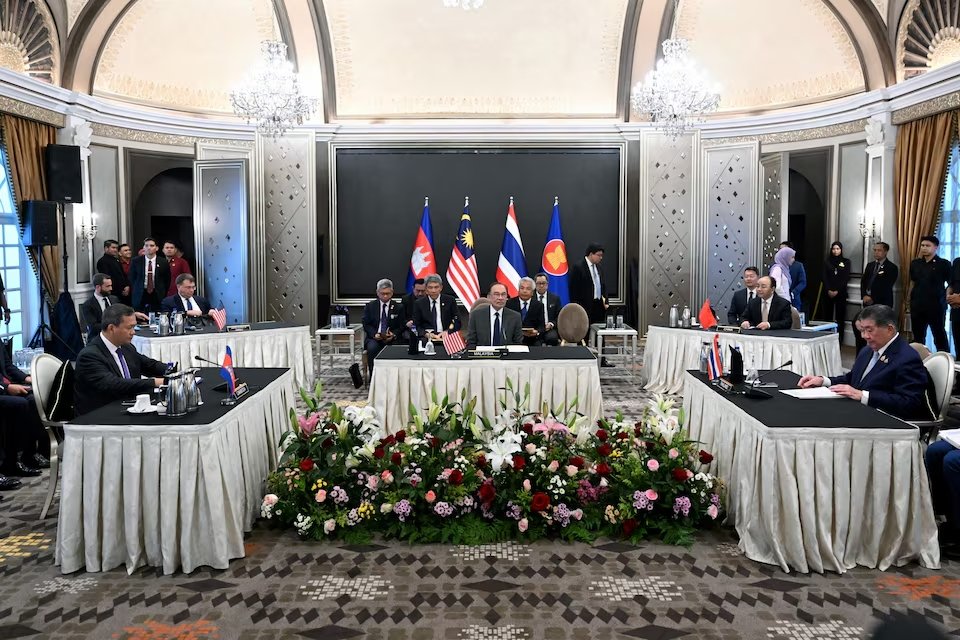
PHNOM PENH, July 28 – A ceasefire agreement between Thailand and Cambodia took effect at midnight (13:00 EDT) on Monday, marking the end of a five-day-long border conflict that claimed at least 38 lives, most of them civilians. The truce follows a significant diplomatic intervention led by Malaysia, the United States, and China, aimed at de-escalating the deadliest clashes between the two Southeast Asian neighbors in more than a decade.
The agreement, reached after high-level talks in Putrajaya, Malaysia, comes after over 300,000 people were displaced by intense fighting along the 800-kilometer (500-mile) border. Leaders of both nations agreed to resume direct communication and establish a monitoring mechanism to ensure the ceasefire holds, offering a glimmer of hope for the thousands affected by the violence.
A Push for Peace Through Diplomacy
The breakthrough came after urgent mediation efforts by Malaysian Prime Minister Anwar Ibrahim, who hosted Thai and Cambodian leaders for a closed-door dialogue at his official residence. Speaking alongside both leaders, Anwar called the ceasefire “a critical step toward restoring peace and regional stability.”
U.S. President Donald Trump was played a central role in facilitating the agreement between the two nations. Over the weekend, he held direct phone calls with both leaders and warned that continued hostilities would jeopardize ongoing trade discussions. The U.S., being the largest export market for both Thailand and Cambodia, imposes a 36% tariff on their goods, and Trump hinted at further economic consequences if the violence persisted.
Following the announcement of the ceasefire, Trump shared his reaction on Truth Social, stating that he had spoken again to the leaders and ordered his trade delegation to resume negotiations. “Ending this conflict has spared countless lives,” he stated. “In just half a year, I’ve brought multiple wars to a close — I take pride in being a President committed to peace.”
Officials from Thailand and Cambodia expressed appreciation for Trump’s role in helping them reach common ground. Thai acting Prime Minister Phumtham Wechayacha expressed gratitude to the U.S. President, saying, “I thanked him from my heart for what we received from him. This has helped our country move beyond this crisis.” He further noted that trade negotiations would now continue with renewed optimism.
Cambodian Prime Minister Hun Manet expressed a similar opinion, highlighting Trump’s key role in achieving the ceasefire and recognizing China’s helpful participation in the peace process. Upon his return, Hun Manet described the outcome as highly successful and expressed hope for a more stable and cooperative relationship with Thailand moving forward.
From Tension to Truce
The recent hostilities were the culmination of long-standing territorial disputes, with tensions simmering since the fatal shooting of a Cambodian soldier in late May. The incident sparked a rapid military buildup and the eventual eruption of open conflict on July 24.
Both sides blamed the other for triggering the clashes, which quickly escalated from small arms fire to heavy artillery bombardments. Thailand even deployed an F-16 fighter jet in a rare and unexpected move, conducting airstrikes that marked a dangerous escalation.
Simmering tensions boiled over last week after Thailand withdrew its ambassador from Phnom Penh and ordered Cambodia’s diplomat to leave following an incident in which a Thai soldier was severely injured by a landmine. Thai authorities accused Cambodian troops of laying the device, a charge Cambodia has strongly denied. In response, Cambodia accused Thailand of targeting civilian areas, including schools and hospitals, describing Thailand’s actions as “unprovoked and premeditated military aggression.”
The violence took a heavy toll on border communities, with multiple houses in Thailand’s Sisaket province left in ruins. One house stood in ruins, with its roof caved in, walls splintered, and power lines dangling dangerously close to the ground.
The landscape in border towns was one of abandonment. Roads were nearly empty, shops shuttered, and the distant sound of artillery occasionally pierced the tense silence. Displaced families found shelter in evacuation camps located well away from the areas of active conflict.
At one such shelter, roughly 40 kilometers from the worst-hit areas, dozens of people queued quietly for food. Children played with stray dogs or sat beside their parents in dusty rooms, uncertain when they would return home.
Nong Ngarmsri, a 54-year-old woman displaced by the fighting, said she hoped to return to her village soon. “I want to go to my children who stayed back,” she said. “I want them to cease firing so that I can go home.”
U.S. Secretary of State Marco Rubio stressed the need to uphold the ceasefire, noting that the United States expects all sides to remain dedicated to resolving the conflict.
While the ceasefire has brought temporary relief, the region remains fragile. The two nations have a long and complex history of border disputes, and observers caution that without sustained diplomatic engagement and transparent monitoring, tensions could resurface.
